| CPIE Project | Page P12 |
||
|
|
|||
|
|
|
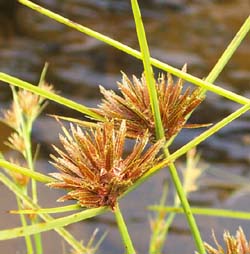 Plants in the Family Cyperaceae (sedges) generally resemble grasses, with fiberous roots but usually with solid or spongy "stems". The saying "sedges have edges" refers to the angularity (typically 3-sided) of many sedge culms (the rising or vertical, stem-like part), but exceptions exist and species with rounded (terete) culms occur, especially among the rushes. Rootstocks (stolon or true stem) may be creeping and beneath the ground, giving rise to dense, monotypic stands of upright culms.
Plants in the Family Cyperaceae (sedges) generally resemble grasses, with fiberous roots but usually with solid or spongy "stems". The saying "sedges have edges" refers to the angularity (typically 3-sided) of many sedge culms (the rising or vertical, stem-like part), but exceptions exist and species with rounded (terete) culms occur, especially among the rushes. Rootstocks (stolon or true stem) may be creeping and beneath the ground, giving rise to dense, monotypic stands of upright culms.
Figure 12A. Two flower heads of Cyperus polystachyos showing numerous, brown spikelets, each having numerous flowers (florets), the floral scales clearly 2-ranked. The spikelets are clustered (forming a flower head) and subtended by bracts (that is, have attached below them leaf-like structures) radiating out from beneath the flower heads). The culms below these bracts are angled (trigonous or 3-sided).
Sedges and rushes are widely distributed in wet places or in water; however, many sedges occur in non-wetland environments. Another group of plants, also known as rushes (Family Juncaceae), resemble many Cyperaceae in growth form and typically also occur in wet places. Identification of a sedge species usually requires consideration of 1) the small flower itself, 2) the structures supporting the flowers (spikelets; see Fig. 1), and/or 3) the achene (or seed; technically, the fruit). The following key encompasses only sedges in Hawai‘i considered to be obligate (OBL) or facultative wet (FACW) This key will eventually be removed, as efforts to maintain and expand have been superseded by two other keys that differ in treating all members of the the Family Cyperaceae in Hawai‘i instead of just aquatic members, as is the case here. The new keys are: Sedges in Grasses and Sedges of the Hawaiian Islands and the CPIE Multi-access key to Family Cyperaceae. |
| 99a | Plant a soft (spongy), green, vertical stem (or culm) lacking leaves (basal sheath without blades may be present). Flower head or heads (called spikelets) at or near tip of stem, in some cases, with a conspicuous bract subtending (found directly below) the flower head, this bract appearing as an upward continuation of the culm. Rushes and some sedges | [100] | |||
| 99b | Stem clasped by one or more long, narrow leaves or with a basal rosette of narrow leaves. Sedges | [105] | |||
| ~~~~~~~~~~~~~~~~~~~~~~~~~~~~~ | |||||
| 100a | (95 & 99) | Multiple, either flattened or ovoid flower heads located at or below the tip of each mature stem. Stems usually greater than 3 mm in diameter | [101] | ||
 
Figure 12B. Spikerush (Eleocharis spp.) | |||||
| 100b | A single, roughly ovoid (egg-shaped) flower head sessile and terminal on (capping) each mature stem (see Fig. 2). Stems between 3 and 60 cm tall, but very narrow (under 2 mm). Spikerushes Keys to differentiate species occurring in Hawai‘i can be found in Wagner, Herbst, and Sohmer (1990) and (updated) in Erickson and Puttock (2006).Eleocharis erythropoda Steud.
E. geniculata (L.) Roem. & Schult. E. obtusa (Willd.) Schult. E. olivacea Torr. E. radicans (Poir.) Kunth E. schaffneri Boeck. |
||||
| ~~~~~~~~~~~~~~~~~~~~~~~~~~~~~ | |||||
| 101a | (100) | Flower glumes (bract below each individual flower) spirally arranged, so the spikelet is round in cross-section (ovoid to oblong in shape); flowers with bristles. Usually multiple flower heads located near tip of each mature culm { and either sessile or borne on narrow "stems" called rays. Culm either trigonous or terete (circular in cross-section) | [102] | ||
| 101b | Flower glumes two-ranked on spikelet, so the spikelet is flattened; flowers without bristles. Genus Cyperus (28 species in Hawai‘i) | [109] | |||
| ~~~~~~~~~~~~~~~~~~~~~~~~~~~~~ | |||||
| 102a | (101) | Some or all spikelets on rays. { Culms usually taller than 0.7 m (2 ft) | [104] | ||
| 102b | All spikelets sessile on culms that are less than 1 m tall | [103] | |||
| ~~~~~~~~~~~~~~~~~~~~~~~~~~~~~ | |||||
| 103a | (102) | Culms terete (round) or 5 to 6 angled; leaf blade absent, basal leaf sheath present mostly as coarse fibers; { Culms usually under 0.7 m (2 ft). Kaluhā. Uncommon on Kaua‘i and rare on Hawai‘i [IND] Schoenoplectus juncoides (Roxb.)Palla |
|||
| 103b | 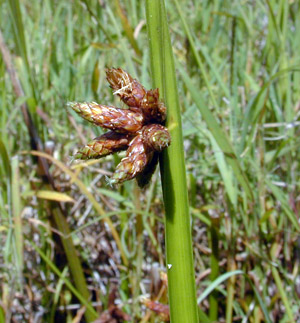 Culms trigonous, up to 1 m tall; leaf blade absent, but basal leaf sheath present, 1 to 10 cm long, brown or light green. Uncommon on Hawai‘i Isl. only [NAT] Culms trigonous, up to 1 m tall; leaf blade absent, but basal leaf sheath present, 1 to 10 cm long, brown or light green. Uncommon on Hawai‘i Isl. only [NAT]Schoenoplectus mucronatus (L.) Palla |
||||
| ~~~~~~~~~~~~~~~~~~~~~~~~~~~~~ | |||||
| 104a | (102) | Flower bristles with backward pointing spines. { Culms terete (round) or with but one or 2 angles throughout, generally less than 2 cm across at base and less than 1.5 m tall; color dark bluish-green. ‘aka‘akai; giant bulrush. Marsh and stream plant. [IND] Schoenoplectus tabernaemontani (C.C. Gimel.) Palla |
|||
| 103b | Flower bristles plumose (feather-like). { Culms trigonous (with three angles), at least towards the upper end, generally 2-3 cm in diameter at base and over 1.5 m tall; color light to medium green. Great or California bulrush. Common marsh plant [NAT] Schoenoplectus californicus (C. A. Mey.) Palla |
||||
| ~~~~~~~~~~~~~~~~~~~~~~~~~~~~~ | |||||
| 105a |
(96) & (99) |
Culms solid, not hollow inside and unbranched; { plant otherwise not entirely as described in 105b | (106) | ||
| 105b | Three-sided culms hollow and sometimes branched at lower nodes; leaves narrow, stiff and armed with exceptionally sharp edges (=saw-grass); nut round in cross-section; { large marsh plants, typically 1 to 6 m (3 to 6 ft) or more high, spreading by keikis that develop on the nodding floral culms. ‘uki, saw-grass [IND] Cladium jamaicense Crantz |
||||
| ~~~~~~~~~~~~~~~~~~~~~~~~~~~~~ | |||||
| 106a | (105) | Floral bracts (scale covering flower parts) with a central keel; bracts (and therefore flowers) arranged in two rows (2-ranked; see Fig. 1) along the axis of the spikelet, the spikelet clearly or somewhat flattened | (107) | ||
| 106b | Floral bracts with or without a conspicuous keel, but arranged spirally (more than 2-ranked) around central axis of spikelet, the spikelet round in cross-section | (124) | |||
| ~~~~~~~~~~~~~~~~~~~~~~~~~~~~~ | |||||
| 107a | (106) | Spikelets mostly several to many-flowered with sometimes one lower empty scale (glume). Genus Cyperus (28 species in Hawai‘i) | (108) | ||
| 107b | Spikelets 1- to 3-flowered, with two or more of the lower scales empty (Rhynchospora spp.) | (130) | |||
| ~~~~~~~~~~~~~~~~~~~~~~~~~~~~~ | |||||
| 108a | (107) | Leaf blades present | (112) | ||
| 108b | Leaf sheaths present clasping culm, but blades absent (or very short in papyrus) | (109) | |||
| ~~~~~~~~~~~~~~~~~~~~~~~~~~~~~ | |||||
| 109a | (107) & (101) | Leaf blades absent or (rarely) very short, clasping base of culms that rise from 1 to 5 m in height; culms weakly trigonous, from 1 to 3 cm in diameter near the base, and terminated by many unequal, arching branches, these each with 3 to 8 secondary branches. An ornamental sedge, escaping and naturalizing by offshoots. Egyptian papyrus [NAT] Cyperus papyrus L.
|
|||
| 109b | Leaf sheaths present, but lacking blades; culms generally under 1.5 m in height and under 1 cm in diameter at the base. Culms terminated by flowering spikes, sessile or on short branches, and leafy bracts, which are longer or shorter than the inflorescence | (110) | |||
| ~~~~~~~~~~~~~~~~~~~~~~~~~~~~~ | |||||
| 110a | (108) | Leafy bracts shorter than infloresence or spikelets sessile on culm with but only one long bract, this extending above the spikelets | (111) | ||
| 110b | Culms rising to 1.5 m, trigonous, about 0.5 cm in diameter, with a rough surface (scabrous). Infloresence subtended by up to twenty-two, 15-27 cm long, leafy bracts. An ornamental sedge, widely naturalized in streams and marshes. Umbrella sedge [NAT] [FACW] Cyperus involucratus Roxb.
|
||||
| ~~~~~~~~~~~~~~~~~~~~~~~~~~~~~ | |||||
| 111a | (110) | Bladeless, dark (reddish brown to purple) leaf sheaths clasping base of culms that rise between 0.3 and 1.1 m height; culms weakly trigonous, up to 0.6 cm in diameter, and terminated by 50 to 250 branches supporting clusters of reddish-brown spikelets. An ornamental sedge grown in water gardens, but possibly naturalized on Kaua‘i. Dwarf papyrus [NAT] Cyperus prolifer Lam.
|
111b |
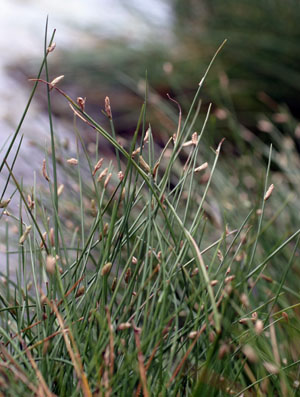 Bladeless, basal sheaths clasping a 0.2 - 1 m high, trigonous culm to 0.5 cm in diameter. Three to 30 terminal, sessile spikelets subtended by several bracts, the longest being rolled and vertical, appearing as a continuation of the culm above the flower head, the second sometimes shorter, sometimes longer than the spikelet cluster. Makaloa [IND] Bladeless, basal sheaths clasping a 0.2 - 1 m high, trigonous culm to 0.5 cm in diameter. Three to 30 terminal, sessile spikelets subtended by several bracts, the longest being rolled and vertical, appearing as a continuation of the culm above the flower head, the second sometimes shorter, sometimes longer than the spikelet cluster. Makaloa [IND]Cyperus laevigatus L. 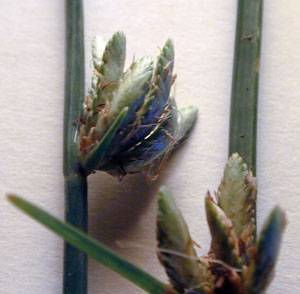
|
|
| ~~~~~~~~~~~~~~~~~~~~~~~~~~~~~ | |||||
| 112a | (108) | Flattened spikelets arranged in compact, typically rather dense and usually somewhat globose heads (see Fig. 1); the culm terminating in one to several such heads on rays or not | (113) | ||
| 112b | Usually flattened to sub-terete spikelets arranged otherwise: generally in clusters of but a few or spaced out along a visible supporting stem, multiple such stems present and these often branching and jointed | (117) | |||
| ~~~~~~~~~~~~~~~~~~~~~~~~~~~~~ | |||||
| 113a | (112) | Spikelets longer than 0.5 cm, with 6 to as many as 40 flowers on each | (114) | ||
| 113b | 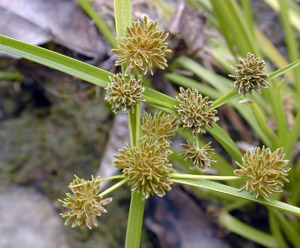 Spikelets with from 8 to 28 flowers, but under 0.6 cm long and 0.8 to 1.2 mm wide; floral bracts or scales under 1 mm in length and width, awnless, purple with green margins; spikelets arranged in compact heads, sessile or on rays to 1 cm long. [NAT] [OBL] Spikelets with from 8 to 28 flowers, but under 0.6 cm long and 0.8 to 1.2 mm wide; floral bracts or scales under 1 mm in length and width, awnless, purple with green margins; spikelets arranged in compact heads, sessile or on rays to 1 cm long. [NAT] [OBL]Cyperus difformis L.
|
||||
| ~~~~~~~~~~~~~~~~~~~~~~~~~~~~~ | |||||
| 114a | (113) | 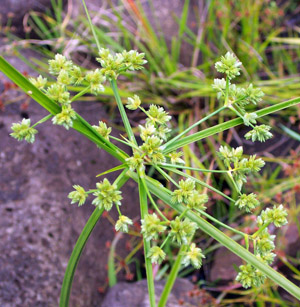 Spikelets yellowish green to reddish brown, oblong and with the end pointed, 6-12 flowered and 0.5 to 2.0 cm long; spikelets in congested globose heads of stacked spikelets. Nut on a short stalk, ellipsoid, and dark brown or black in color. { Plants between 0.3 amd 0.9 m tall. Hamakua (Hawai‘i Isl.) and possibly Kaua‘i only. [NAT] [OBL] Spikelets yellowish green to reddish brown, oblong and with the end pointed, 6-12 flowered and 0.5 to 2.0 cm long; spikelets in congested globose heads of stacked spikelets. Nut on a short stalk, ellipsoid, and dark brown or black in color. { Plants between 0.3 amd 0.9 m tall. Hamakua (Hawai‘i Isl.) and possibly Kaua‘i only. [NAT] [OBL]?Cyperus eragrostis L. |
|||
| 114b | Spikelets oblong elliptic, dark purple to brownish black; spikelets 6 to 18 mm long and 2 to 2.6 mm wide, with 6 to 32 flowers. Plant 0.2 to 0.6 m high. Nut on a short stalk, laterally compressed, and dark brown in color. { Plants 0.2 to 00.6 m tall. Hamakua area of Hawai‘i Isl. only. Bloodscale sedge [NAT] [FACW] Cyperus sanguinolentus Vahl.
|
||||
| 114c | Spikelets yellowish green to reddish brown, the spikelets not in groupings that appear stacked. Nut yellowish, compressed or not. Height usually under 0.5 m | (115) | |||
| ~~~~~~~~~~~~~~~~~~~~~~~~~~~~~ | |||||
| 115a | (114) | Floral bract (scale) not awned. Nut laterally compressed, elliptic in cross-section. Lanceolate spikelets crowded with 8 to 40 flowers, spikelet tips acute. Common in and out of wetlands | (116) | ||
| 115b | Each floral bract terminating in a short awn or recurved mucro. Nut trigonous(three-sided in cross-section). { Green and brown, ovate lanceolate spikelet with 8 to 20 flowers, tip rounded. Pu‘uka‘a. Rare and only on main islands north of Lana‘i [END] [FACW] [E] Cyperus trachysanthos Hook. and Arnott
|
||||
| ~~~~~~~~~~~~~~~~~~~~~~~~~~~~~ | |||||
| 116a | (115) | Yellowish-brown flower heads somewhat lax, with 8 - 26 flowers. { basal leaf blades sometimes exceeding the inflorescence [IND] [FACW] Cyperus polystachyos holosericeus (Link) Koyama
|
|||
| 116b | Flower heads compact and globose, pale to deep reddish-brown in color and with 10 to 40 flowers per spikelet (see Fig. 1). [IND] [FACW] Cyperus polystachyos polystachyos Rottb.
|
||||
| ~~~~~~~~~~~~~~~~~~~~~~~~~~~~~ | |||||
| 117a | (112) | Spikes linear and terete (that is cylindrical): flattened or somewhat rounded spikelets arranged more or less loosely around and up the length of primary and secondary branches terminal on the culm; spikelet stem jointed and breaking apart at maturity. (Species that are sometimes treated in the genus, Mariscus) | (118) | ||
| 117b | Flattened spikelets in loose digitate clusters of from 1 to 6, located at the ends of primary and secondary branches; spikelet stem not jointed; { each ovate linear spikelet 3 to 18 mm long. [NAT] [FACW] Cyperus halpan L.
|
||||
| ~~~~~~~~~~~~~~~~~~~~~~~~~~~~~ | |||||
| 118a | (117) | Spikelets with fewer than 10 flowers each, flattened or sub-terete (flattened only a little) | (119) | ||
| 118b | Spikelets with 10 to 25 flowers each, flattened | (120) | |||
| ~~~~~~~~~~~~~~~~~~~~~~~~~~~~~ | |||||
| 119a | (118) | 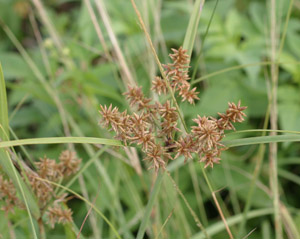 Spikelets flattened, to 0.6 cm long, with 5-7 flowers each. { coarse, perennial herb to 1.1 m tall, with a stiff, roughened, 3-sided culm, 3-5 mm in diameter. ‘ahu‘awa [IND] [FACW] Spikelets flattened, to 0.6 cm long, with 5-7 flowers each. { coarse, perennial herb to 1.1 m tall, with a stiff, roughened, 3-sided culm, 3-5 mm in diameter. ‘ahu‘awa [IND] [FACW]Cyperus javanicus Houtt.
|
|||
| 119b | Spikelets sub-terete, to 1.0 cm long, with 3-4 flowers each. { Perennial herb to 0.5 m tall, with a smooth, 3-sided culm, 3 mm in diameter. Meyen's sedge [NAT] [FACW] Cyperus meyenianus Kunth
|
||||
| ~~~~~~~~~~~~~~~~~~~~~~~~~~~~~ | |||||
| 120a | (118) | Spikes tapering somewhat towards tips (that is, spikelets become shorter towards the top of the spike); Spikelets flattened, hairy, 0.6 to 1.5 cm long, not jointed, with 8-25 flowers each. { Annual or perennial herb to 0.9 m tall, with an acutely trigonous culm. Found only on Kaua‘i. [NAT] [FACW] Cyperus pilosus Vahl
|
|||
| 120b | Spikes not tapering towards tips; spikelets flattened, not hairy, 1.0 to 2.5 cm long, and jointed between the 10-25 flowers, breaking apart at maturity forming a corky, winged attachment for the fruit. { Annual or short-lived perennial herb to 1.4 m tall, with a smooth, 3-sided culm. Pu‘uka‘a [IND] [FACW] Cyperus odoratus L.
|
||||
| ~~~~~~~~~~~~~~~~~~~~~~~~~~~~~ | |||||
| ~~~~~~~~~~~~~~~~~~~~~~~~~~~~~ | |||||
| 124a | (106) | Spikelets longer than wide, tapering towards the top. Leaves variable. Styles either flattened or thread-like | (125) | ||
| 124b | Spikelets mostly about as long as wide, spherical. Leaves long and narrow (1-2 mm x 15-40 cm). Styles of flowers thread-like [NAT] [OBL] Fimbristylis miliacea (L.) Vahl |
||||
| ~~~~~~~~~~~~~~~~~~~~~~~~~~~~~ | |||||
| 125a | (124) | Style of flower flattened, the margins distinctly fimbriate. Island of O‘ahu, only [NAT] [OBL] Fimbristylis ferruginea (L.) Vahl
|
|||
| 125b | Style flattened hardly at all, margins not fimbriate. Spikelets single at the ends of primary branches radiating from the top of the culm, along with 1 to 4 mostly short, leafy bracts. Islands of Hawai‘i and Kaua‘i, only [NAT] [FACW] Fimbristylis aestivalis (Retz.) Vahl |
||||
| ~~~~~~~~~~~~~~~~~~~~~~~~~~~~~ | |||||
|
|
|||
|
|
Vascular plants |
||
| INSTRUCTIONS INDEX REFERENCES | 22 | ||